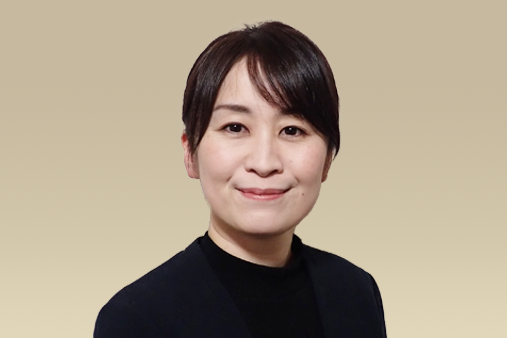JSPS Topics
Special Content

Researcher Interviews

MUKAI Hiromi
Senior Researcher
Forestry and Forest Products Research Institute, Forest Research and Management Organization
Biography
• Born in 1986. Ph.D. in Agriculture. Completed doctoral program at the United Graduate School of Agricultural Sciences, Kagoshima University.
• Awarded JSPS Research Fellowships (DC1 in 2011, PD in 2014).
• Joined the Forestry and Forest Products Research Institute as a tenure-track researcher before assuming current position.
• Recipient of the 4th JSPS Ikushi Prize (2014)
• Recipient of the 22nd Japan Prize in Agricultural Sciences, Achievement Award for Young Scientists (2023)
Research Theme
Studies on Parent-Embryo Interaction and Its Communication Systems in Subsocial Stink Bugs
• Born in 1986. Ph.D. in Agriculture. Completed doctoral program at the United Graduate School of Agricultural Sciences, Kagoshima University.
• Awarded JSPS Research Fellowships (DC1 in 2011, PD in 2014).
• Joined the Forestry and Forest Products Research Institute as a tenure-track researcher before assuming current position.
• Recipient of the 4th JSPS Ikushi Prize (2014)
• Recipient of the 22nd Japan Prize in Agricultural Sciences, Achievement Award for Young Scientists (2023)
Research Theme
Studies on Parent-Embryo Interaction and Its Communication Systems in Subsocial Stink Bugs

“My research related with JSPS Ikushi Prize focuses on the unique parental care behaviors that subsocial stink bugs have towards their embryos.”
My research related with JSPS Ikushi Prize focuses on the unique parental care behaviors that subsocial stink bugs have towards their embryos.
I discovered two remarkable phenomena in relation to the burrower bug (Adomerus rotundus), which exhibits subsocial behavior in which the mother protects her eggs, carries food to the hatched larvae, and cares for them up to independence.
1. Just before hatching, the mother vigorously shakes while holding the egg mass.
2. Then, immediately afterward, dozens of eggs hatch simultaneously.
I hypothesized that a close vibratory communication exists between the parent and the embryos inside the eggs and that the mother's vibrations facilitate synchronized hatching, and then tested the hypothesis. My aim was also to elucidate the mechanism and adaptive significance of synchronized hatching and to clarify how parent-embryo communication could evolve under different conditions. As a result, I discovered that in subsocial burrower bugs, including this species, “bidirectional parent-embryo communication” is widely established, where species-specific vibratory signals from the parent promote hatching. Additionally, I found that synchronized hatching helps to prevent future cannibalism among the larvae. This phenomenon of a parent transmitting vibratory signals to the embryos to trigger hatching had never been reported in any insect before. At that time, this discovery attracted significant attention both domestically and internationally.
While conducting research on parent-embryo communication, I also focused on how female burrower bugs frequently rotate the egg clutch they protect, wanting to elucidate this behavior. In birds, egg rotation is believed to prevent the embryo from adhering to the eggshell, thereby ensuring normal embryonic development. My experiments, however, revealed that in burrower bugs, egg clutch rotation helps equalize accumulated temperature, leading to synchronized embryonic development. This became an important discovery as it demonstrated a new form of parental care in arthropods, where insect parents regulate temperature to control embryonic development.
I discovered two remarkable phenomena in relation to the burrower bug (Adomerus rotundus), which exhibits subsocial behavior in which the mother protects her eggs, carries food to the hatched larvae, and cares for them up to independence.
1. Just before hatching, the mother vigorously shakes while holding the egg mass.
2. Then, immediately afterward, dozens of eggs hatch simultaneously.
I hypothesized that a close vibratory communication exists between the parent and the embryos inside the eggs and that the mother's vibrations facilitate synchronized hatching, and then tested the hypothesis. My aim was also to elucidate the mechanism and adaptive significance of synchronized hatching and to clarify how parent-embryo communication could evolve under different conditions. As a result, I discovered that in subsocial burrower bugs, including this species, “bidirectional parent-embryo communication” is widely established, where species-specific vibratory signals from the parent promote hatching. Additionally, I found that synchronized hatching helps to prevent future cannibalism among the larvae. This phenomenon of a parent transmitting vibratory signals to the embryos to trigger hatching had never been reported in any insect before. At that time, this discovery attracted significant attention both domestically and internationally.
While conducting research on parent-embryo communication, I also focused on how female burrower bugs frequently rotate the egg clutch they protect, wanting to elucidate this behavior. In birds, egg rotation is believed to prevent the embryo from adhering to the eggshell, thereby ensuring normal embryonic development. My experiments, however, revealed that in burrower bugs, egg clutch rotation helps equalize accumulated temperature, leading to synchronized embryonic development. This became an important discovery as it demonstrated a new form of parental care in arthropods, where insect parents regulate temperature to control embryonic development.

A female of the burrower bug (Adomerus rotundus) holding an egg mass just before hatching. ©MUKAI Hiromi

“Winning this Prize has bolstered my sense of "confidence" and "pride" as a researcher.”
Winning this Prize has bolstered my sense of "confidence" and "pride" as a researcher. At the time, my research was often perceived as having little apparent value to society or people. Being selected for this award showed me that my research perspectives and the originality and creativity of my work were recognized and valued. I was encouraged by the fact that the findings of my research on burrower bugs, which I had devoted myself to with passion for about six years stemming from my undergraduate days, were simply appreciated as “genuinely interesting.” Refreshing my admiration for the freedom of research, this recognition has strengthened my resolve to dive into the vast and boundless frontiers of science that lie ahead.
Winning the Ikushi Prize has also influenced my current research direction. At the time I received it, I had been working as a postdoctoral researcher at my current institute for three years before being formally appointed as a researcher. During that period, I interacted with agricultural and forestry professionals, policymakers, and government officials, gaining experiences that led me to believe my cultivated expertise and techniques might actually contribute to society.
Currently, I am working on pest control technologies that manipulate the sensory functions and information processing of insects. I am also involved in developing pest control technologies that apply these findings to influencing insect sensory functions, enabling precise behavioral manipulations that can protect crops from pests—without relying on chemical pesticides.
Such environmentally low-impact pest control strategies are critical to realizing sustainable agriculture and forestry. Accordingly, I approach this work with a strong sense of mission, believing that it will benefit both living organisms and the environment.
Winning the Ikushi Prize has also influenced my current research direction. At the time I received it, I had been working as a postdoctoral researcher at my current institute for three years before being formally appointed as a researcher. During that period, I interacted with agricultural and forestry professionals, policymakers, and government officials, gaining experiences that led me to believe my cultivated expertise and techniques might actually contribute to society.
Currently, I am working on pest control technologies that manipulate the sensory functions and information processing of insects. I am also involved in developing pest control technologies that apply these findings to influencing insect sensory functions, enabling precise behavioral manipulations that can protect crops from pests—without relying on chemical pesticides.
Such environmentally low-impact pest control strategies are critical to realizing sustainable agriculture and forestry. Accordingly, I approach this work with a strong sense of mission, believing that it will benefit both living organisms and the environment.

"What may seem like a failure at first could hold the potential for unexpected new discoveries later."
I sincerely hope that young researchers will enjoy engaging in the process of research. Research is often a series of failures, and things rarely go as planned. However, what may seem like a failure at first could hold the potential for unexpected new discoveries later.
I believe that keeping an open and flexible mindset allows us to spot hidden insights in the unexpected. I hope to always maintain such a perspective myself.
I believe that keeping an open and flexible mindset allows us to spot hidden insights in the unexpected. I hope to always maintain such a perspective myself.
*Profile information accurate as of the time of the interview.
[ Special Content along the JSPS Brochure: Researcher Interviews ]
Be sure to check out more interviews with the other researchers as well!
Dr. YAMANAKA Shinya - Recipient of Grant-in-Aid for Scientific Research (KAKENHI) | Dr. SUGIYAMA Masafumi - Awardee of JSPS Research Fellowships for Young Scientists | Dr. MUKAI Hiromi - Recipient of the "JSPS Ikushi Prize" | Dr. SUGIMURA Miki - Senior Program Officer, Research Center for Science Systems
Be sure to check out more interviews with the other researchers as well!
Dr. YAMANAKA Shinya - Recipient of Grant-in-Aid for Scientific Research (KAKENHI) | Dr. SUGIYAMA Masafumi - Awardee of JSPS Research Fellowships for Young Scientists | Dr. MUKAI Hiromi - Recipient of the "JSPS Ikushi Prize" | Dr. SUGIMURA Miki - Senior Program Officer, Research Center for Science Systems
JSPS Brochure
The brochure containing the Researcher Interviews is available at the following link.
・JSPS Brochure 2024-2025 (PDF/6.3MB)
The brochure containing the Researcher Interviews is available at the following link.
・JSPS Brochure 2024-2025 (PDF/6.3MB)
Please follow us for the latest news!


